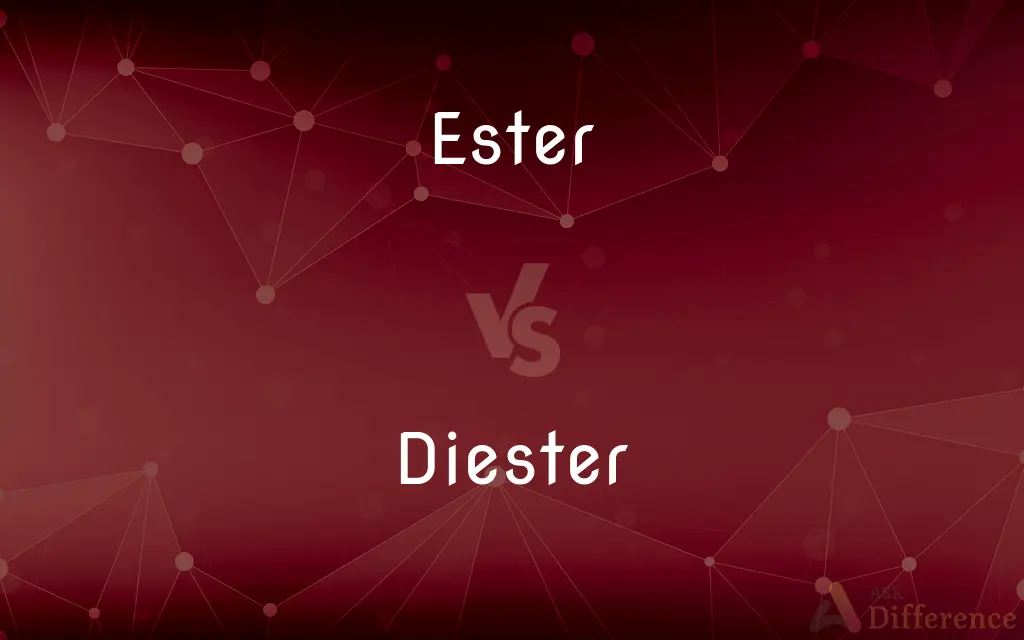Ester vs. Diester — What's the Difference?
Edited by Tayyaba Rehman — By Urooj Arif — Updated on April 27, 2024
Esters are organic compounds derived from acids where one hydrogen is replaced by an alkyl group; diesters have two such replacements.

Difference Between Ester and Diester
Table of Contents
ADVERTISEMENT
Key Differences
Esters are chemical compounds typically formed by the reaction of a carboxylic acid and an alcohol, where oxygen is bonded to one alkyl or aryl group. In contrast, diesters are a type of ester that contain two ester functional groups, usually resulting from the esterification of dicarboxylic acids with two alcohol groups.
Esters often have pleasant smells and are used in fragrances and flavorings, making them common in everyday products. On the other hand, diesters, due to their structure, often have specific applications in industry such as plasticizers or solvents.
The formation of an ester involves the removal of water in a condensation reaction, typically facilitated by an acid catalyst. Diesters, however, often require more controlled reaction conditions to ensure the formation of two ester groups without unwanted side reactions.
Esters are soluble in organic solvents and have relatively low boiling points, which makes them volatile and suitable for use in perfumes. Conversely, diesters tend to have higher boiling points and may be less volatile, which is beneficial in applications requiring stability under heat.
In terms of reactivity, esters can be hydrolyzed back into the original acid and alcohol under certain conditions. Diesters, while also hydrolyzable, might proceed through intermediate stages where only one ester group is hydrolyzed initially.
ADVERTISEMENT
Comparison Chart
Definition
Organic compound with one ester functional group.
Organic compound with two ester functional groups.
Formation
Formed from a carboxylic acid and an alcohol.
Formed from a dicarboxylic acid and two alcohol groups.
Applications
Used in fragrances, flavors.
Used as plasticizers, solvents.
Boiling Point
Generally lower, making them volatile.
Higher, less volatile.
Reactivity
Can be hydrolyzed to acid and alcohol.
Hydrolysis can be more complex, may occur in stages.
Compare with Definitions
Ester
Used extensively in the food industry as flavorings.
Methyl butyrate is added to beverages for a fruity flavor.
Diester
Used as solvents and softeners in various industrial applications.
Dimethyl phthalate is used in insect repellent formulations.
Ester
A compound formed from an acid and an alcohol with the elimination of water.
Ethyl acetate, used in nail polish remover, is an ester.
Diester
Often synthesized from dicarboxylic acids.
Diethyl adipate is a diester made from adipic acid.
Ester
Common in biological systems as fats and oils.
Triglycerides, found in human fat tissue, are esters.
Diester
A compound containing two ester groups.
Phthalate esters are diesters used as plasticizers.
Ester
Often characterized by a fruity smell.
Isoamyl acetate has a banana-like smell and is an ester.
Diester
Less volatile than simple esters.
Dibutyl phthalate is used in nail polish to reduce chipping.
Ester
Soluble in organic solvents but not in water.
Propyl acetate is used in perfumes due to its solubility in organics.
Diester
Hydrolysis yields two moles of alcohol and one mole of dicarboxylic acid.
Hydrolysis of diethyl phthalate produces ethanol and phthalic acid.
Ester
An ester is a chemical compound derived from an acid (organic or inorganic) in which at least one –OH hydroxyl group is replaced by an –O– alkyl (alkoxy) group, as in the substitution reaction of a carboxylic acid and an alcohol. Glycerides are fatty acid esters of glycerol; they are important in biology, being one of the main classes of lipids and comprising the bulk of animal fats and vegetable oils.
Diester
(chemistry) any organic compound containing two ester functional groups
Ester
Any of a class of compounds derived from an oxyacid, usually resulting from the reaction of an oxyacid and an alcohol with the elimination of water.
Ester
(organic compound) A compound most often formed by the condensation of an alcohol and an acid, with elimination of water, which contains the functional group carbon-oxygen double bond (i.e., carbonyl) joined via carbon to another oxygen atom.
Ester
An ethereal salt, or compound ether, consisting of an organic radical united with the residue of any oxygen acid, organic or inorganic; thus the natural fats are esters of glycerin and the fatty acids, oleic, etc.
Ester
Formed by reaction between an acid and an alcohol with elimination of water
Common Curiosities
What makes diesters different from simple esters in terms of applications?
Diesters are primarily used in industrial applications such as plasticizers and solvents due to their chemical stability.
What is an ester?
An ester is an organic compound made by replacing the hydrogen of an acid by an alkyl or other group.
Why are esters important in food flavoring?
Esters are responsible for many of the fruity smells and tastes in food products.
How are esters used in everyday products?
Esters are commonly used in fragrances, flavorings, and as solvents in various beauty products.
Can esters be found naturally?
Yes, many esters are naturally occurring in fruits and are responsible for their aromas.
Are esters reactive?
Esters can react, particularly by hydrolysis, reverting back to the original acid and alcohol.
How do the boiling points of esters and diesters compare?
Esters typically have lower boiling points compared to diesters, making them more volatile.
What is a diester?
A diester is an ester compound containing two ester groups within its structure.
What role do diesters play in the manufacture of plastics?
Diesters act as plasticizers which increase the plasticity or fluidity of the material to which they are added.
What is the process of forming an ester called?
The chemical reaction to form an ester is known as esterification.
How does the structure of diesters affect their properties?
The presence of two ester groups often enhances the thermal stability and decreases the volatility of diesters.
Are there environmental concerns associated with diesters?
Some diesters, particularly phthalates, have been scrutinized for environmental and health impacts.
Can diesters be hydrolyzed in the same way as esters?
Yes, but diesters may undergo hydrolysis in stages depending on the reaction conditions.
How are esters involved in the beauty industry?
Esters are used in various cosmetics for their solvent properties and pleasant smells.
What is a common use of diesters in commercial products?
Diesters are commonly used as softeners in vinyl and other polymers.
Share Your Discovery

Previous Comparison
Maori vs. Aboriginal
Next Comparison
Reply vs. RespondAuthor Spotlight
Written by
Urooj ArifUrooj is a skilled content writer at Ask Difference, known for her exceptional ability to simplify complex topics into engaging and informative content. With a passion for research and a flair for clear, concise writing, she consistently delivers articles that resonate with our diverse audience.
Edited by
Tayyaba RehmanTayyaba Rehman is a distinguished writer, currently serving as a primary contributor to askdifference.com. As a researcher in semantics and etymology, Tayyaba's passion for the complexity of languages and their distinctions has found a perfect home on the platform. Tayyaba delves into the intricacies of language, distinguishing between commonly confused words and phrases, thereby providing clarity for readers worldwide.
















































